PU'UHONUA O HONAUNAU NHP
A Cultural History of Three Traditional Hawaiian Sites
on the West Coast of Hawai'i Island

|
PU'UKOHOLA HEIAU NHS • KALOKO-HONOKOHAU NHP • PU'UHONUA O HONAUNAU NHP A Cultural History of Three Traditional Hawaiian Sites on the West Coast of Hawai'i Island |

|
|
Site Histories, Resource Descriptions, and Management Recommendations |
CHAPTER VII:
PU'UKOHOLA HEIAU NATIONAL HISTORIC SITE (continued)
C. Mailekini Heiau
1. Traditional Construction History
Little is known of Mailekini Heiau, located on the slope between Pu'ukohola Heiau and the coast. Similar in construction to that of Puukohola, with massive stone walls inland and open to the sea on the west, it is, however, smaller in size. Archeologist Edmund J. Ladd stated that Mailekini temple site is an older site probably representing the inter-chiefdom and inter-district or island warfare of the period prior to 1790. It is a temple site undoubtedly built by the district ruling chief." [111] It is in connection with one of the early South Kohala chiefs that the heiau is mentioned in the early literature, as the location where the aging Alapa'inui, governing Kohala about 1760, conducted ceremonies transferring his rule and lands to his son Keawe'opala. [112]
As mentioned previously, several authors believe that Kamehameha first began restoring Mailekini in response to Kapoukahi's prophesy, but later moved work higher up the hill. [113]
Dwarfed by the magnificent structure looming over it from above, Mailekini Heiau was little noticed and only briefly mentioned, if at all, by visitors in the historical period. Whether it was functioning up until the time of Kamehameha's construction of the present Pu'ukohola Heiau is unclear, although early references seem to indicate that it was already abandoned and unused by that time. Isaac Iselin, supercargo on the Maryland, at Kawaihae in 1807, mentioned noticing "two remarkable 'morays,' built by Tamaahmaah during his two years' stay at this place. . . ." [114] This could have been merely an assumption on his part or might suggest that Kamehameha I had performed some work on Mailekini, although it is fairly certain that it had been originally constructed long before.
 |
| Illustration 47. View west of Mailekini Heiau, taken by J.F.G. Stokes in 1906. Courtesy Bernice P. Bishop Museum, Honolulu. |
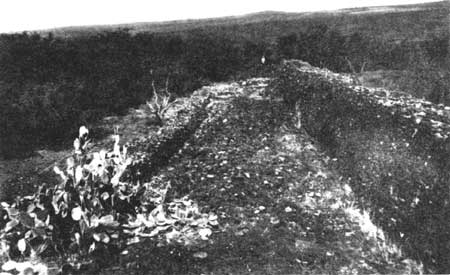 |
| Illustration 48. View north of Mailekini Heiau, taken by J.F.G. Stokes in 1906. Courtesy Bernice P. Bishop Museum, Honolulu. |
2. Mailekini Becomes a Fort
Although Kamehameha's rule over the Hawaiian islands seemed secure, his major rivals having been killed or thoroughly subjected, he was undoubtedly aware that threats to his power could arise at any moment. In addition, the increasing presence of Europeans might have made him uneasy and mindful of the vigilance he would need to keep both his subjects and arriving foreigners in line. Influenced by his exposure to European military strategy and Western weapons of destruction, Kamehameha decided to build forts with mounted guns to protect his major ports. Reinforced by a navy, these safeguards would hopefully ensure the longevity of his reign. De Freycinet noted that
During the reign of Tamehameha, cannons, guns, and other firearms from Europe were introduced to the Sandwich Islands, and there was a fairly large number of them when we visited these parts. There was an excellent battery consisting of twenty-two 22-calibre cannons, all on naval mounts, in Kayakakoua [Kaleakekua] near the northern landing of the bay, and two small copper mortars located in front of Princess Keohoua's house. . . . There were also several cannons, of which we could not learn the number, located on the beach of Kohaihai [Kawaihae]. [115]
About 1812, Kamehameha sent cannons, obtained from traders, to Kawaihae Bay to be mounted under the charge of John Young. Marion Kelly notes that about 1816, Gov. John Adams transported seven guns from Kawaihae to Oahu, probably for the use of the fort there. Apple states that by 1819 Young had installed twenty-one ship's guns on the foundations of Mailekini Heiau, where they guarded the king's residence nearby as well as the harbor. [116] As de Freycinet neared the anchorage of Kawaihae on his journey in August of that year, he "saluted the Sandwich Islands flag with eleven guns, which were answered in equal number by a battery mounted on shore near the royal residence." [117] The exact number of guns on the heiau is unclear. De Freycinet says later that, upon landing to pay his respects to King Kamehameha on the beach, he "advanced in the direction of the King, who grasped my hand with cordiality and told me, through M. Rives, that he would salute me with seven guns." [118]
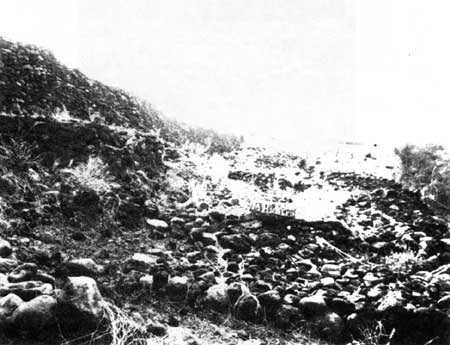 |
| Illustration 49. View south over burials in disturbed northern section of Mailekini Heiau platform, taken by J.F.G. Stokes in 1906. Courtesy Bernice P. Bishop Museum, Honolulu. |
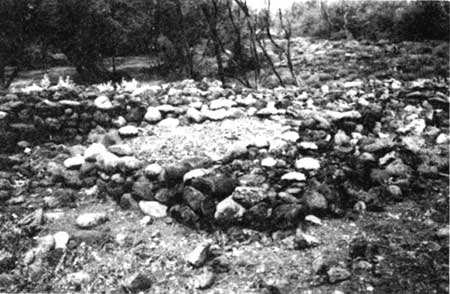 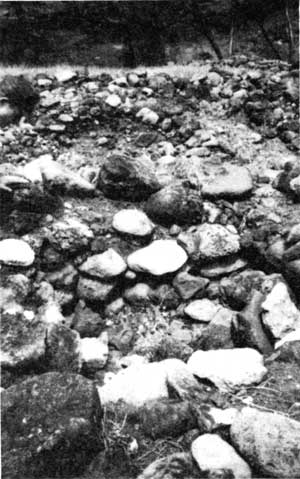 |
| Illustration 50. Burials at north end of Mailekini Heiau. NPS photo, 1989. |
Jacques Arago also talked about Mailekini Heaiu, stating that
Immediately below this monument [Pu'ukohola] is a fort, pretty regularly built, and mounting twenty-two guns. It commands the town and the bay; and although surmounted itself by the morai, there is no danger of an enemy's attempting to possess himself of this height, so great is the reverence of the people for the religion of their fathers. [119]
This description implies that some type of construction work was involved in setting up this "fort," although the extent of these modifications is unclear. According to Arago, the fortifications at Kamakahonu in Kailua consisted of "twenty odd guns of small caliber, protected by casemates, or sheds covered with coconut leaves." [120] The Reverend William Ellis described the ruined heiau of Ahu'ena at Kailua in 1823, noting that after the abolition of the kapu system, the governor converted the structure into a fort by widening the stone wall next to the sea and placing cannon on it. [121] When guns were added to Mailekini Heiau, its religious functions moved to a nearby enclosure in the Pelekane area. Arago noted that
the name of Temple is given to a small spot enclosed by a hedge of cocoa-nut tree branches: in the middle are two huts; one of these serves as a residence for the priest, in the other are deposited the offerings with which the idols are presented; these are consecrated, and suspended on the branches of a banana-tree planted in the enclosure, or from the top of a high pole. [122]
The extent of the garrison at Kawaihae is unclear. Arago describes the fortifications at Kamakahonu, stating they were manned by five or six warriors, without uniforms and carrying guns on their shoulders, whose sentry duty consisted of pacing from one end of the fortifications to the other. Their "tour of duty" lasted fifteen minutes. [123] Kamehameha had a good-sized military contingent at Kawaihae, according to de Freycinet:
The monarch was already awaiting me on the beach; he was dressed in the full uniform of a captain in the British Navy. . . . The King . . . had his principal officers a little behind him; some of them wore magnificent red and yellow feather cloaks; others wore cloaks of scarlet cloth. Others again wore shorter capes of the same style.... Some wore helmets. A fairly large number of soldiers, scattered here and there, lent an air of great variety to this strange picture because of the odd and irregular fashion of their uniforms. No order, no uniformity of appearance and movement existed amongst them; each one carried his gun as it was convenient to him or as it was most comfortable. [124]
Some of the king's soldiers must have been manning the fort in order to fire the salute to de Freycinet.
3. Historical Descriptions
a) Reverend William Ellis, 1823
In 1823 the Reverend William Ellis, after viewing Puukohola,
visited Mairikini, another heiau, a few hundred yards nearer the shore. It was nearly equal in its dimensions to that on the summit of the hill, but inferior in every other respect. It appeared to have been literally crowded with idols, but no human sacrifices were offered to any of its gods. [125]
No explanation is provided for his assumption that there had once been many idols at Mailekini Heiau. If taken literally, his description implies that there was some physical evidence of this, either in the form of numerous niches or of a few remaining images. It is interesting to note that Ellis stated in regard to Ahu'ena Heiau in 1823:
The idols are all destroyed, excepting three, which are planted on the wall, one at each end, and the other in the centre, where they stand like sentinels amidst the guns, as if designed by their frightful appearance to terrify an enemy. [126]
The relationship between Mailekini, Puukohola, and Hale-o-Kapuni heiau is unclear, either in terms of a physical or ceremonial connection. Whether human sacrifices took place at Mailekini in the pre-European contact period is unknown. Perhaps Mailekini was in some way connected with the shark heiau, with human sacrifices being made at Mailekini and the bodies then being deposited in the water for the sharks to devour. Hale-o-Kapuni appears also to be an ancient structure. Hawaiian mythology as recorded by Fornander and presented in the section on Pu'ukohola history indicates that a heiau on Pu'ukohola was the site of a sacrifice during the time of Lonoikamakahiki. It is generally assumed that this refers to a heiau on top of the hill predating the present one rather than to Mailekini. Possibly Mailekini, if not actually used for human sacrifices itself, was connected in some way with rituals at the temple on the hill.
b) John Kirk Townsend, 1834-37
John Kirk Townsend, a naturalist visiting Hawai'i between 1834 and 1837 collecting natural history specimens, also stopped to see Pu'ukohola and Mailekini. He described the latter as the place to which the bodies of dead chiefs were carried prior to interment. There they lay in state for a certain period of time, according to their rank, before their flesh was stripped off and tossed into the sea and their bones deposited in caves or subterranean vaults. [127] Presumably he was told this by a native guide or other local informant.
4. Later Descriptions
a) John F. G. Stokes, 1906
Stokes described Mailekini as being probably older than Pu'ukohola and affected by more internal changes, particularly recent burials in the north end of the interior. [128]
b) Thomas Thrum, 1908
In his Hawaiian Annual for 1908, in which he compiled a list of heiau sites throughout the Hawaiian Islands, Thomas Thrum described Mailekini as being 270 by 65 feet in size, with a low perpendicular wall in front, a heavier, sloping one in back, and no internal features except graves. [129] Little is known about these graves that appear to have been added around the turn of the century. Located primarily at the northern end of the interior area, many have been disturbed, possibly due to exhumation of remains for reinterment elsewhere. [130] A local resident, Solomon Akau, remembered going to Mailekini in the early 1920s with his great-grandmother to decorate a grave, although he did not know whose it was. [131]
c) Deborah Cluff et al., 1969
Although Lyons mapped Mailekini Heiau in 1853, the only detailed description and mapping of its features is presented by Cluff et al. as a result of their 1969 survey work prior to construction of the Kawaihae small boat harbor. Their observations in full may be found in that document; the following general remarks are taken from their work:
The site is bordered on the mauka (east), north, and south sides by a high, massive wall (1), the top of which is paved with small, water-worn basalt and coral rocks. . . .
The makai [seaward] side of the heiau is bordered by a low wall of well patinated rocks of various shapes, sizes and textures. . . . Whereas the north, south, and east walls are very high and massive, the west wall is low., . . . It probably derives from a separate period of construction from the other sides. . . .
Between the makai wall and the interior platform of Mailekini is a ditch. . . . Whether or not this feature functioned as a ditch is uncertain. . . . Another possibility is that this section was so constructed, or altered, when the heiau was converted into a fortress with the installation of cannon by John Young in the early 19th century.. . .
The interior of the site can be roughly divided into three areas: the south, central, and north sections. . . . The south sector consists basically of a dirt floor which slopes downward toward the center. . . .
Abutting on the south wall are two mounds. . . .
The remains of a small enclosure . . . are found in the southeast corner. . . .
Primarily, a long concave pavement covering the natural terrain forms the central section of the heiau. . . .
Feature 12 is a line of stones found while clearing the rubble. This could be an indication that a structure once stood at that spot. . . . Three possible graves were found in the central section of Mailekini. . . .
The northern part of Mailekini is the most disturbed area. [132]
Eleven possible grave sites not shown on Lyons's 1853 survey but noted by Stokes in 1906 were documented during this survey within the temple platform area — two in the southern section, three in the central portion, and six in the northern section. The contents of two of the burial chambers had been removed, either through vandalism or for reburial. Both features contained wooden coffin fragments. The characteristics of all grave features indicated late use (historic period) of the heiau by local residents as a burial ground:
Normally such activity in a temple area was taboo, but it seems that whoever buried the corpses in this heiau was sure of the demise of the old Hawaiian gods, and thus, the impotency of the consequences of breaking the sanctity of such a sacred place. [133]
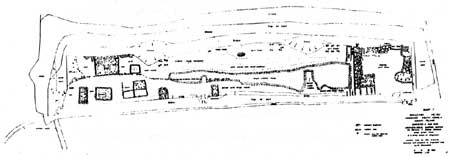 |
| Illustration 51. Survey map of Mailekini Heiau, 1969. From Yosihiko H. Sinoto, "Pre-Calibration Shot Survey at Puu Kohola and Mailekini Heiau, Kawaihae, South Kohala, Hawaii Island," p. 97. |
| <<< Previous | <<< Contents >>> | Next >>> |